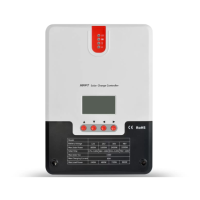Take a 12V system as an example. As the solar panel's peak voltage (Vpp) is approximately 17V
while the battery's voltage is around 12V, when charging with a conventional charge controller, the
solar panel's voltage will stay at around 12V, failing to deliver the maximum power. However, the
MPPT controller can overcome the problem by adjusting the solar panel's input voltage and current
in real time, realizing a maximum input power.
Compared with conventional PWM controllers, the MPPT controller can make the most of the solar
panel's max. power and therefore provide larger charging current. Generally speaking, the latter can
raise the energy utilization ratio by 15% to 20% in contrast with the former.
MPPT point
VP curve
VI curve
Meanwhile, due to changing ambient temperature and illumination conditions, the max. power
point varies frequently, and our MPPT controller can adjust parameter settings according to the
environmental conditions in real time, so as to always keep the system close to the max. operating
point. The whole process is entirely automatic without the need of human intervention.
U
(
V
)
I
(
A
)
20℃
50℃
70℃
60℃
40 ℃
30℃
I (A)
U( V)
Current decreases with dwindling light
Open-circuit voltage decreases with dwindling light
With temperature dropping,
current stays stable and
power increases
Solar panel temperature
Open-circuit voltage decreases with rising temperature
Fig. 1-3 Relation between solar panel output
characteristics and illumination
Fig. 1-4 Relation between solar panel output
characteristics and temperature
Fig. 1-2 Solar panel output characteristic curve
1.5 Charging Stages Introduction
As one of the charging stages, MPPT can’t be used alone, but has to be used together with
boost charging, floating charging, equalizing charging, etc. to complete charging the battery. A
complete charging process includes: fast charging, sustaining charging and floating charging.
The charging curve is as shown below:
a) Fast charging
At the fast charging stage, as the battery voltage has not reached the set value of full voltage (i.e.
equalizing/ boost voltage) yet, the controller will perform MPPT charging on the battery with the maximum
solar power. When the battery voltage reaches the preset value, constant voltage charging will begin.
b) Sustaining charging
When the battery voltage reaches the set value of sustaining voltage, the controller will switch to constant
voltage charging. In this process, no MPPT charging will be performed, and meanwhile the charging current
will also gradually decrease. The sustaining charging stage itself consists of two sub-stages, i.e. equalizing
charging and boost charging, the two of which are not carried out in a repeated manner, with the former
getting activated once every 30 days.
Boost charging
By default, boost charging generally lasts for 2h, but users can adjust preset values of duration and boost
voltage point according to the actual needs. When the duration reaches the set value, the system will then
switch to floating charging.
3
4
Charging current
Time
Max. current
Cumulati ve t im e: 3h
Duration : 2h
(range: 10 to 600m in )
A
Fast charging
B
C
Bo ost
B
u
l
k
Charging current
Ti me
Sustaining
charging
Floating
charging
Equalizing charging voltage
Boost charging voltage
Floating charging voltage
Charging return voltage
Fig. 1-5 SLD Battery charging stages diagram
A
Fast
charging
B
Sustaining
charging
Fig. 1-6 LI Battery charging stages diagram
Charging current
Charging current
Time
Ti me

